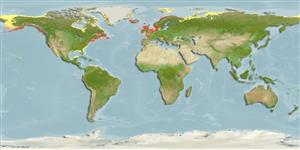Common names from other countries
Environment: milieu / climate zone / depth range / distribution range
Écologie
; profondeur 0 - 55 m (Ref. 83435). Temperate; 85°N - 15°N, 180°W - 39°E
Distribution
Pays | Zones FAO | Écosystèmes | Occurrences | Introductions
Atlantic Ocean, Eastern Pacific , Arctic and the Mediterranean Sea. Subtropical to polar.
Length at first maturity / Taille / Poids / Âge
Maturity: Lm ? range ? - ? cm Max length : 2.0 cm TL mâle / non sexé; (Ref. 822)
Assumed maximum length from Ref. 822.
Life cycle and mating behavior
Maturité | Reproduction | Frai | Œufs | Fécondité | Larves
This species has separate sexes and are difficult to distinguish externally.
Turgeon, D.D., J.F. Quinn Jr., A.E. Bogan, E.V. Coan, F.G. Hochberg, W.G. Lyons, P.M. Mikkelsen, R.J. Neves, C.F.E. Roper, G. Rosenberg, B. Roth, A. Scheltema, F.G. Thompson, M. Vecchione and J.D. Willams. 1998. (Ref. 1667)
Statut dans la liste rouge de l'IUCN (Ref. 130435: Version 2024-1)
statut CITES (Ref. 108899)
Not Evaluated
Not Evaluated
Utilisations par l'homme
| FishSource |
Outils
Plus d'informations
Taille/ÂgeCroissanceLongueur-poidsLongueur-longueurMorphologieLarvesAbondance
Sources Internet
Estimates based on models
Preferred temperature
(Ref.
115969): 5.3 - 13.2, mean 9.6 (based on 636 cells).
Vulnérabilité
Low vulnerability (10 of 100).
Catégorie de prix
Unknown.
